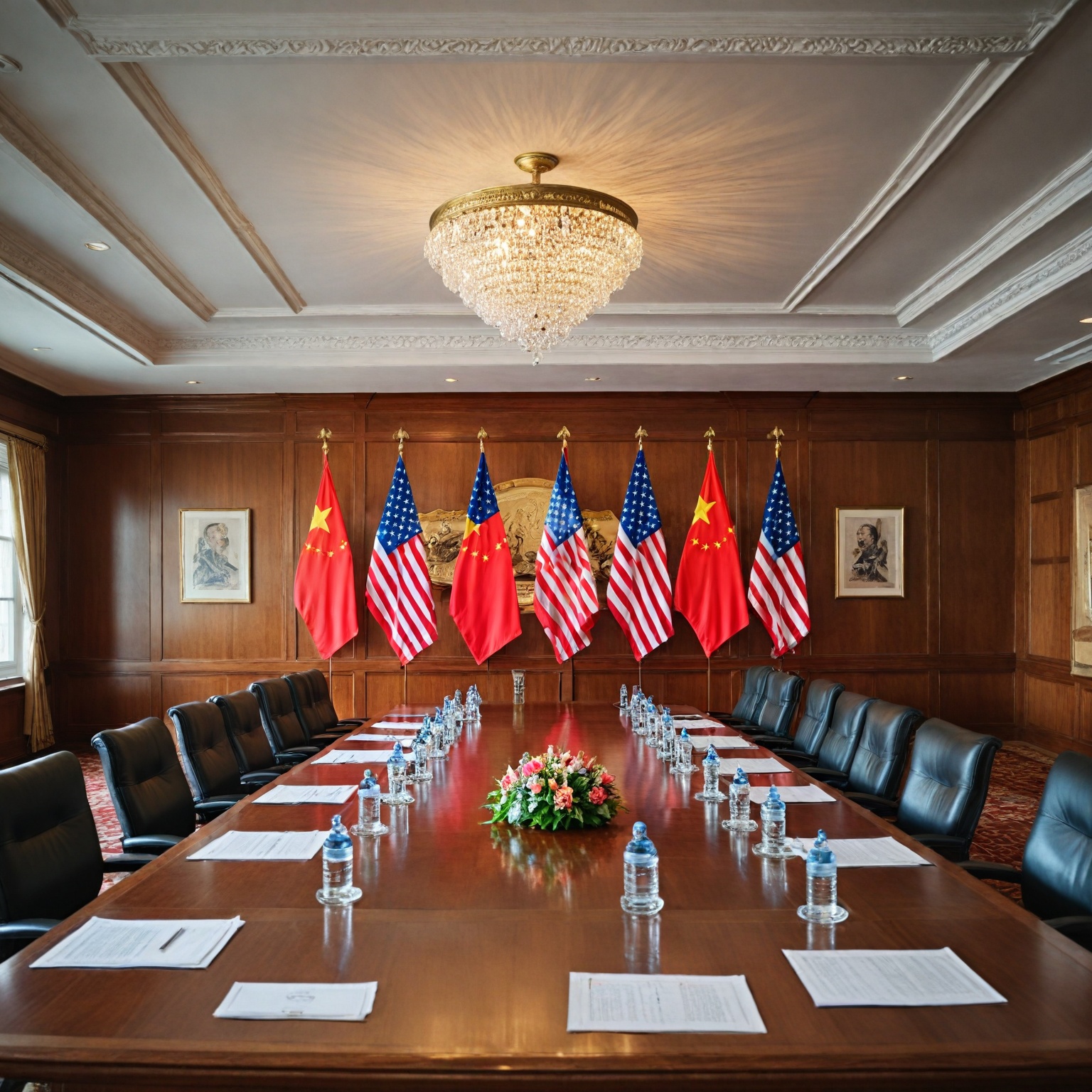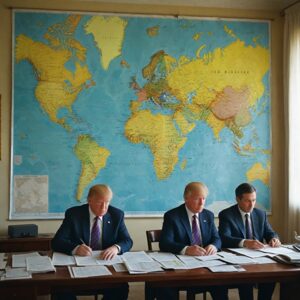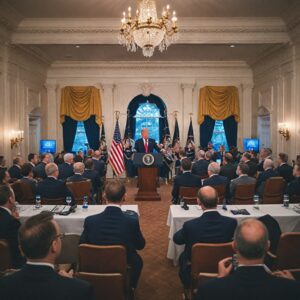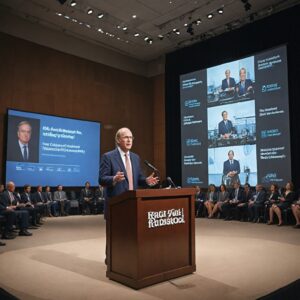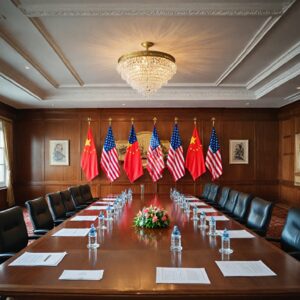Summary
The ongoing trade negotiations between the United States and China have garnered significant attention due to their profound impact on global economic stability and financial markets. These talks aim to ease tensions stemming from a protracted trade war initiated in recent years, characterized by the imposition of tariffs and retaliatory measures that disrupted supply chains and contributed to market uncertainty. Given that the U.S. and China together account for approximately 43 percent of the world’s gross domestic product (GDP) and nearly half of global manufacturing output, the outcome of these discussions holds considerable weight for the international economy.
Recent diplomatic engagements, including meetings in Geneva and London involving senior officials such as U.S. Treasury Secretary Scott Bessent and China’s Vice Premier He Lifeng, have fostered cautious optimism. Both countries have agreed on temporary tariff reductions and the establishment of ongoing consultation mechanisms to address trade disputes and structural issues, though substantial progress on long-standing U.S. demands—such as transitioning China’s economy from an export-driven model toward greater consumer spending—remains limited. Despite the absence of a comprehensive breakthrough, market reactions to these developments have been positive, with stock futures for major U.S. indexes rallying amid hopes of reduced trade friction.
The negotiations occur within a complex strategic context where economic interdependence coexists with geopolitical rivalry. U.S. policies continue to restrict China’s access to critical technologies and sensitive sectors, particularly in semiconductors and rare earth minerals, reflecting concerns over national security and technological competition. While tariffs on certain Chinese imports have been temporarily eased, key duties remain in place, and the U.S. has indicated it will not negotiate tariff rates below 10 percent, signaling a cautious stance toward trade liberalization.
Media coverage has highlighted both the significance and challenges of the talks, noting their role in shaping investor sentiment and global market dynamics. Although investors have responded favorably to the prospect of de-escalation, analysts emphasize that uncertainties persist due to geopolitical risks and the limited scope of current agreements. This delicate balance underscores the importance of continued diplomatic engagement to foster a more stable and balanced U.S.-China trade relationship moving forward.
Background
The economic relationship between the United States and China has evolved significantly over the past several decades. Diplomatic normalization began in 1979, paving the way for China’s integration into the global trade system. China applied to rejoin the General Agreement on Tariffs and Trade (GATT) in 1986 and, after prolonged negotiations, officially became a member of the World Trade Organization (WTO) in December 2001. By 2023, the combined economies of the U.S. and China accounted for 43 percent of global gross domestic product (GDP) and nearly 48 percent of worldwide manufacturing output, underscoring the importance of their trade relationship.
Despite this economic interdependence, tensions have risen in recent years, culminating in a trade war marked by the imposition of tariffs and retaliatory measures. Tariffs imposed during this period have effectively acted as trade embargoes, disrupting supply chains and causing uncertainty in financial markets globally. These tariffs notably excluded goods from Canada and Mexico under the U.S.-Mexico-Canada Agreement (USMCA), which replaced NAFTA. The trade war has led to a series of negotiations and consultations aimed at resolving disputes, including efforts by key figures such as U.S. Trade Representative Jamieson Greer and China’s Vice Premier He Lifeng.
In response to ongoing tensions, the two nations have established multiple dialogue mechanisms, including the Economic Working Group initiated in 2023 by U.S. Treasury Secretary Janet Yellen and Vice Premier He. These forums have served as platforms for expressing grievances but have yet to yield significant changes to China’s state-dominated, export-driven economic model, which the U.S. aims to see shift toward increased consumer spending. The U.S. goods trade deficit with China reached $295.4 billion in 2024, the largest deficit with any trading partner, highlighting the stakes involved in these discussions.
Recent trade talks have adopted a more conciliatory tone, signaling cautious optimism among investors and policymakers. U.S. Commerce Secretary Howard Lutnick noted positive progress during meetings in London, although expectations for a major breakthrough remain tempered. Both countries have committed to continued communication, cooperation, and mutual respect, with plans to implement agreed actions by mid-May 2025 to promote a more balanced trade relationship.
Recent Developments Leading to Current Trade Talks
The current phase of U.S.-China trade negotiations has been shaped by a series of developments aimed at de-escalating tensions that began with the imposition of tariffs during the previous administration. A natural point of departure for renewed talks is to build upon the 2020 Phase One Trade Agreement, which was generally acceptable to Beijing and laid a foundation for future dialogue. However, the path forward remains uncertain, as geopolitical events could disrupt or delay negotiations and potentially trigger renewed escalation.
In May 2025, senior U.S. officials, including Treasury Secretary Scott Bessent and Trade Representative Jamieson Greer, engaged in talks with Chinese counterparts in Geneva, resulting in announcements of “substantial progress” toward resolving tariff disputes. This progress contributed to positive market reactions, with stock futures rising amid hopes for a thaw in trade tensions. The negotiations also involved establishing a new consultation mechanism to continue discussions on economic and trade relations. The designated representatives for these ongoing talks include Vice Premier He Lifeng for China and Treasury Secretary Bessent along with Trade Representative Greer for the United States. Discussions are planned to be held alternately in China, the U.S., or a mutually agreed third country.
The World Trade Organization (WTO) has also played a role; its Director-General Ngozi Okonjo-Iweala welcomed the positive outcomes of the talks and encouraged both sides to leverage momentum to reduce trade tensions. Nonetheless, the WTO’s ability to adjudicate past tariff disputes has been hindered by the paralysis of its appellate body due to U.S. objections to judicial appointments.
Concurrent with diplomatic engagements, U.S. Commerce Secretary Howard Lutnick noted that trade talks held in London were progressing well, signaling continued commitment from both parties to negotiate in a complex environment marked by issues such as China’s export restrictions on critical minerals introduced earlier in the year. The broader trade context also includes the United States-Mexico-Canada Agreement (USMCA), which exempts goods from Canada and Mexico from the U.S. tariffs that have affected Chinese imports. While the temporary easing of tariffs offers relief to businesses, it also generates pent-up demand, leading to higher transportation costs and a rush to schedule shipments during the negotiating window, impacting global markets positively.
Historical patterns reveal that importers often accelerate shipments ahead of tariff increases, as observed during earlier tariff rounds in 2018 and 2019, which temporarily boosted import growth before leading to sharper declines post-implementation. These economic dynamics, alongside geopolitical uncertainties and ongoing dialogues, set the stage for the current round of U.S.-China trade negotiations, with market participants closely monitoring developments amid hopes for a more stable trade relationship.
Stock Futures Overview
Stock futures are financial contracts that allow investors to buy or sell stock indexes or individual stocks at predetermined prices for delivery at a future date. These contracts are traded on exchanges worldwide and provide a mechanism for investors to manage risk and secure prices amid market uncertainties. Unlike speculators who assume risk in hopes of profit, hedgers utilize futures to offset potential losses in their underlying positions, effectively locking in prices to create predictability and security in volatile markets.
Futures are versatile instruments covering a wide range of assets including commodities, stock indexes, and government bonds. They enable investors to tailor their hedging strategies based on specific needs and risk tolerance. For instance, when a perfect hedge is not available, market participants may use a “cross hedge,” selecting futures contracts that are closely correlated but not identical to their underlying holdings, such as using S&P 500 futures to hedge a diversified stock portfolio. Most hedgers opt for partial hedges, balancing the trade-off between reducing risk and preserving potential profits.
Margin requirements are a critical aspect of trading stock futures. Exchanges set minimum margin levels that traders must maintain, which brokers can augment depending on market conditions and volatility. These requirements help regulate leverage, protect market stability by reducing forced liquidations, and safeguard brokers and exchanges during turbulent periods. Margin rates can fluctuate intraday as risk teams monitor real-time market conditions.
Market reactions to geopolitical and economic developments often influence stock futures. For example, futures prices showed little change ahead of U.S.-China trade talks as investors awaited clarity on negotiations, reflecting the cautious sentiment. Conversely, optimistic statements from U.S. Treasury Secretary Scott Bessent regarding “substantial progress” in trade discussions have led to rallies in futures markets, with notable gains in Nasdaq, S&P 500, and Dow Jones futures. These fluctuations underscore the sensitivity of futures markets to news and policy developments.
While some concerns exist about the role of futures in market volatility, studies suggest that although futures attract speculators due to relatively low margin requirements, they do not necessarily increase overall market volatility. Short-term spikes, such as those seen in the late 1980s, do not represent long-term trends in market behavior. Additionally, the high cost of establishing short positions has been noted as a factor limiting excessive volatility in futures markets.
Impact of Recent US-China Trade Talks on Stock Futures
The recent US-China trade talks have significantly influenced stock futures, with investors responding positively to signs of de-escalation in the ongoing trade war. The conciliatory tone during negotiations has alleviated some of the uncertainty that had been weighing on financial markets, prompting optimism among investors despite the absence of an immediate breakthrough.
Following the announcement of a temporary tariff reduction agreement, Wall Street’s major indexes experienced sharp gains, with the S&P 500 reaching its highest level since early March. On the day after the talks, the Dow Jones Industrial Average rose by 2.81%, marking its highest close in nearly two months. Futures for key indices also pointed to a strong rally, with Nasdaq futures up 3.8%, S&P 500 futures rising 2.8%, and Dow futures gaining 3.1%.
Investors particularly focused on the easing of tariffs on consumer goods and the 90-day tariff reduction window, which has led to expectations of increased import activity from China as businesses stock up on goods. This pent-up demand is anticipated to affect transport prices and supply chain dynamics in the near term. Notably, goods covered under the USMCA trade pact between the United States, Canada, and Mexico remain exempt from the 25% tariffs, which provides some relief to businesses in those countries amid the broader tariff environment.
Market sentiment has been further buoyed by the implication that the reduced tariff barriers could encourage other countries to negotiate similar trade terms with the United States, potentially fostering a more stable international trade environment. Additionally, sectors closely tied to the trade talks, such as large-cap Chinese stocks and U.S. semiconductor companies, have seen bullish trading activity as investors position themselves to benefit from the easing tensions.
However, some tariffs, including the 25% tariffs on approximately $250 billion of Chinese imports, remain in place, with further reductions contingent upon progress in future negotiations. The U.S. has also indicated it will not negotiate tariff rates below 10%, maintaining a degree of caution in trade policy moving forward. This tempered stance contributes to a cautiously optimistic market outlook as investors continue to monitor ongoing discussions scheduled to resume in London and beyond.
Detailed Summary of Recent Trade Talks
The recent trade talks between the United States and China have centered on continuing the dialogue initiated under the 2020 Phase One Trade Agreement, which was generally acceptable to Beijing and serves as a natural starting point for further negotiations. However, the path toward an updated trade agreement remains uncertain due to potential geopolitical disruptions that could trigger intermittent escalations or pauses in negotiations. China’s approach includes leveraging technical and administrative measures to delay shipments to the U.S. market, even if additional tariffs or export controls are not imposed, while also strengthening regional trade partnerships that could serve as alternative export routes.
High-level officials representing both countries have actively engaged in these discussions. On the U.S. side, Treasury Secretary Scott Bessent, Commerce Secretary Howard Lutnick, and U.S. Trade Representative Jamieson Greer have led the talks. Their Chinese counterparts include Vice Premier He Lifeng, who has played a pivotal role in economic policy discussions. The latest meetings took place in Geneva in May 2025 and London in subsequent sessions, with both sides expressing cautious optimism. The talks aim to build on a mid-May 2025 agreement to temporarily lower retaliatory tariffs and establish a mechanism for continued dialogue, alternating between China, the United States, or a mutually agreed third country.
Despite these efforts, longstanding U.S. objectives—such as shifting China’s export-driven and state-dominated economic model toward one more reliant on consumer spending—have seen limited progress. The dialogues have mostly served as platforms to air bilateral grievances without substantial advancement on structural economic reforms desired by Washington. Tariff rates are expected to persist, but not at the elevated levels imposed during the Trump administration. For instance, Commerce Secretary Lutnick has confirmed that the United States will not negotiate tariff rates lower than 10%, reflecting a policy stance consistent with recent agreements, including the U.S.-UK trade deal.
Economic analyses indicate that the tariffs imposed have had complex effects. A 2023 study by economists Knut Blind and Moritz Böhmecke-Schwafert suggests that, in the medium to long term, U.S. tariff hikes could paradoxically lead to increased exports from China to the U.S., based on historical trade data from OECD and BRICS countries over the past two decades. Both countries recognize that the existing tariffs function as an effective embargo, a situation neither side desires to perpetuate. This shared understanding underscores the mutual interest in pursuing balanced trade relations without decoupling their intertwined economies.
The broader context of these talks includes continued U.S. measures aimed at restricting China’s access to critical technologies and sensitive sectors. Under the Biden administration, tariffs have been increased on key Chinese imports such as electric vehicles, steel, aluminum, and semiconductors. Additionally, export controls and investment bans have been introduced to prevent technology transfers that could bolster China’s military capabilities. These actions reflect a complex strategic environment in which economic interdependence coexists with geopolitical competition. The combined economic weight of the U.S. and China remains significant, accounting for 43 percent of global GDP and nearly half of global manufacturing output in 2023. Moreover, China is a major export market for the U.S., with exports exceeding $195 billion in 2024.
Economic Diplomacy Strategies in Trade Negotiations
Economic diplomacy between the United States and China has centered on addressing long-standing trade imbalances, reducing tariffs, and fostering cooperation on critical economic issues such as rare earth minerals and technology transfers. The recent renewal of trade talks builds on the 2020 Phase One Trade Agreement, which provided a foundation generally acceptable to Beijing, serving as a natural starting point for further negotiations. Both parties have underscored the importance of their bilateral trade relationship, not only for their own economies but also for the global market, given that together they represent nearly 43 percent of global GDP and almost half of global manufacturing output as of 2023.
The U.S. delegation, including Treasury Secretary Scott Bessent, Commerce Secretary Howard Lutnick, and U.S. Trade Representative Jamieson Greer, has pursued a pragmatic approach aimed at balancing trade flows and revitalizing the U.S. manufacturing sector while encouraging China to curb overproduction. This approach reflects a mutual acknowledgment that neither side seeks economic decoupling but rather aims for more balanced trade relations.
Recent talks in London and Geneva have focused on reducing retaliatory tariffs and easing tensions around rare earth mineral exports—an area where the U.S. has accused China of slow-walking commitments made in previous agreements. U.S. officials have described the discussions as “fruitful” and “good,” although they remain cautious about the pace of progress. Both countries have reaffirmed their commitment to continued communication, cooperation, and mutual respect as essential elements for moving forward in the
Prioritized Economic Sectors and Policy Areas
The ongoing trade talks between the United States and China have centered on several key economic sectors and policy areas that are critical to both countries’ strategic and economic interests. One of the primary focal points has been the imposition and potential reduction of tariffs across multiple industries. The Biden administration notably quadrupled tariffs on Chinese electric vehicles, tripled those on steel and aluminum, and doubled duties on semiconductors to curb China’s technological advancements and protect U.S. manufacturing. In response, China implemented countermeasures, including export restrictions on rare earth minerals and magnets—materials vital to high-tech manufacturing—which were later agreed to be lifted as part of de-escalation efforts.
Semiconductors and advanced technology represent a particularly sensitive policy area. The United States has introduced unprecedented export controls aimed at limiting Beijing’s access to cutting-edge technologies that could enhance China’s military capabilities, alongside bans on U.S. investment in sensitive tech sectors. These measures underscore the strategic competition embedded within the trade dialogue.
Financial markets have been closely watching developments in these sectors. Positive signals from trade talks have buoyed investor sentiment, particularly regarding Chinese large-cap stocks and U.S. semiconductor companies, both of which stand to benefit from eased tensions. The semiconductor industry’s performance is viewed as a bellwether for the broader technology sector, which remains under pressure from global supply chain disruptions and geopolitical uncertainties.
The rare earth minerals sector has also been a pivotal issue. The Trump administration accused China of delaying the approval of additional critical mineral exports pledged during previous negotiations, underscoring the strategic leverage China holds in this domain. Subsequent agreements to lift export restrictions on these materials have been welcomed by U.S. trade representatives and markets alike, as they are essential inputs for many high-tech and defense-related industries.
Beyond tariffs and technology, the trade deficit remains a significant policy concern. The U.S. goods trade deficit with China reached $295.4 billion in 2024, the largest with any trading partner, prompting discussions on mechanisms to ensure continued dialogue and progress towards a more balanced trade relationship. The establishment of such mechanisms is seen as crucial for sustaining long-term cooperation and mitigating economic disruptions.
Economic Implications of Trade Talks
The ongoing U.S.-China trade negotiations have significant economic implications, influencing global markets and supply chains. The natural starting point for further discussions is to build upon the 2020 Phase One Trade Agreement, which was largely acceptable to Beijing. However, the path toward an updated trade deal remains uncertain, with geopolitical developments having the potential to disrupt or escalate tensions unpredictably. This tentative de-escalation has already provided relief to financial markets, which had been jittery over the possibility of a collapse in U.S.-China trade flows that might have severely disrupted supply chains, evoking memories of shortages seen during the COVID-19 pandemic. In anticipation, U.S. imports from China are expected to surge in the short term as businesses and retailers increase their inventories.
Trade talks have also prompted market responses worldwide. For instance, goods originating from Canada and Mexico under the United States–Mexico–Canada Agreement (USMCA) are exempt from the 25 percent tariffs, offering some reprieve for North American businesses. Despite this, the effects of high tariffs linger, as companies face pent-up demand and increased transportation costs while attempting to schedule shipments within the 90-day negotiating window. Following announcements related to the trade discussions, global stock markets experienced notable gains.
The significance of the U.S.-China trade relationship is underscored by the substantial economic interdependence between the two nations. Together, their economies accounted for approximately 43 percent of the global gross domestic product (GDP) and nearly 48 percent of global manufacturing output in 2023. China remains one of the largest export markets for U.S. goods and services—second only to Mexico—with U.S. exports to China projected to exceed $195 billion in 2024. Conversely, the United States is the leading export market for China, highlighting the reciprocal nature of their economic ties.
Media Coverage and Public Perception
Media coverage of the US-China trade talks has been extensive, highlighting both the complexities of the negotiations and their broader economic implications. Journalists like Ana Swanson and David Pierson of The New York Times have provided detailed reporting on the developments, including clarifications about the scheduling of trade discussions and the nuances of diplomatic engagement between the two countries. The dialogue between U.S. officials, including Treasury Secretary Scott Bessent and U.S. Trade Representative Jamieson Greer, and their Chinese counterparts has been portrayed as a platform for airing grievances but has faced criticism for making limited progress toward shifting China’s economic model from export-driven to consumer-driven growth.
Public perception, as reflected in media narratives, tends to focus on the immediate market reactions to trade developments. Announcements such as the temporary lowering of retaliatory tariffs and the scheduling of renewed talks in Geneva were linked to significant movements in global stock markets, demonstrating investor sensitivity to trade news. However, concerns about market volatility persist, with commentators noting that optimism around the talks may be somewhat premature given the uncertain geopolitical landscape and the potential for unexpected disruptions. Historical parallels have been drawn to prior market shocks, underscoring worries that factors like low margin requirements for futures trading could amplify stock price fluctuations during periods of trade tension.

